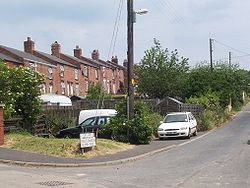
Woolley Colliery
Encyclopedia

Village
A village is a clustered human settlement or community, larger than a hamlet with the population ranging from a few hundred to a few thousand , Though often located in rural areas, the term urban village is also applied to certain urban neighbourhoods, such as the West Village in Manhattan, New...
on the edge of the Barnsley
Metropolitan Borough of Barnsley
The Metropolitan Borough of Barnsley is a metropolitan borough of the metropolitan county of South Yorkshire, England. Its main town is Barnsley....
and Wakefield district
City of Wakefield
The City of Wakefield is a local government district of West Yorkshire, England, with the status of a city and metropolitan borough. Wakefield is the district's administrative centre. The district includes the "Five Towns" of Normanton, Pontefract, Featherstone, Castleford and Knottingley. Other...
s in Yorkshire
Yorkshire
Yorkshire is a historic county of northern England and the largest in the United Kingdom. Because of its great size in comparison to other English counties, functions have been increasingly undertaken over time by its subdivisions, which have also been subject to periodic reform...
, England
England
England is a country that is part of the United Kingdom. It shares land borders with Scotland to the north and Wales to the west; the Irish Sea is to the north west, the Celtic Sea to the south west, with the North Sea to the east and the English Channel to the south separating it from continental...
. The village itself is in South Yorkshire
South Yorkshire
South Yorkshire is a metropolitan county in the Yorkshire and the Humber region of England. It has a population of 1.29 million. It consists of four metropolitan boroughs: Barnsley, Doncaster, Rotherham, and City of Sheffield...
whilst the former colliery
Coal mining
The goal of coal mining is to obtain coal from the ground. Coal is valued for its energy content, and since the 1880s has been widely used to generate electricity. Steel and cement industries use coal as a fuel for extraction of iron from iron ore and for cement production. In the United States,...
is situated in West Yorkshire
West Yorkshire
West Yorkshire is a metropolitan county within the Yorkshire and the Humber region of England with a population of 2.2 million. West Yorkshire came into existence as a metropolitan county in 1974 after the passage of the Local Government Act 1972....
. Union leader Arthur Scargill
Arthur Scargill
Arthur Scargill is a British politician who was President of the National Union of Mineworkers from 1982 to 2002, leading the union through the 1984–85 miners' strike, a key event in British labour and political history...
started work at the colliery aged 14 in 1953.
The village is known locally as 'Mucky Woolley', a tribute to its coal mining heritage and to distinguish it from the more affluent village of Woolley
Woolley, West Yorkshire
Woolley is a village and civil parish in the City of Wakefield in West Yorkshire, England. It has a population of 575. Until 1974 it formed part of Wakefield Rural District....
situated 2 miles away. The village gets its name from the coal mines which were working there at least as early as 1850. About that time two rows of small terrace cottages were built for the workmen. Several coal seams outcrop in the hillside so coal was probably mined thereabouts for many years before that but only on a small scale until railway transport began. The pit was one of the largest in West Yorkshire; in 1980, it employed 1514 men underground and 428 on the surface.
The main mine began as a pair of tunnels into the hillside in the Barnsley Bed seam. As time went on, vertical shafts were sunk to get at the deeper seams. In the 1960s there were three shafts in the pit yard and a fourth, for extra ventilation, about a mile to the east. At that time around 17,000 tons of high quality coal were produced each week from four seams.
After the 1984-5 strike, the men from North Gawber colliery were also transferred to Woolley. The pit finally closed in 1987.

